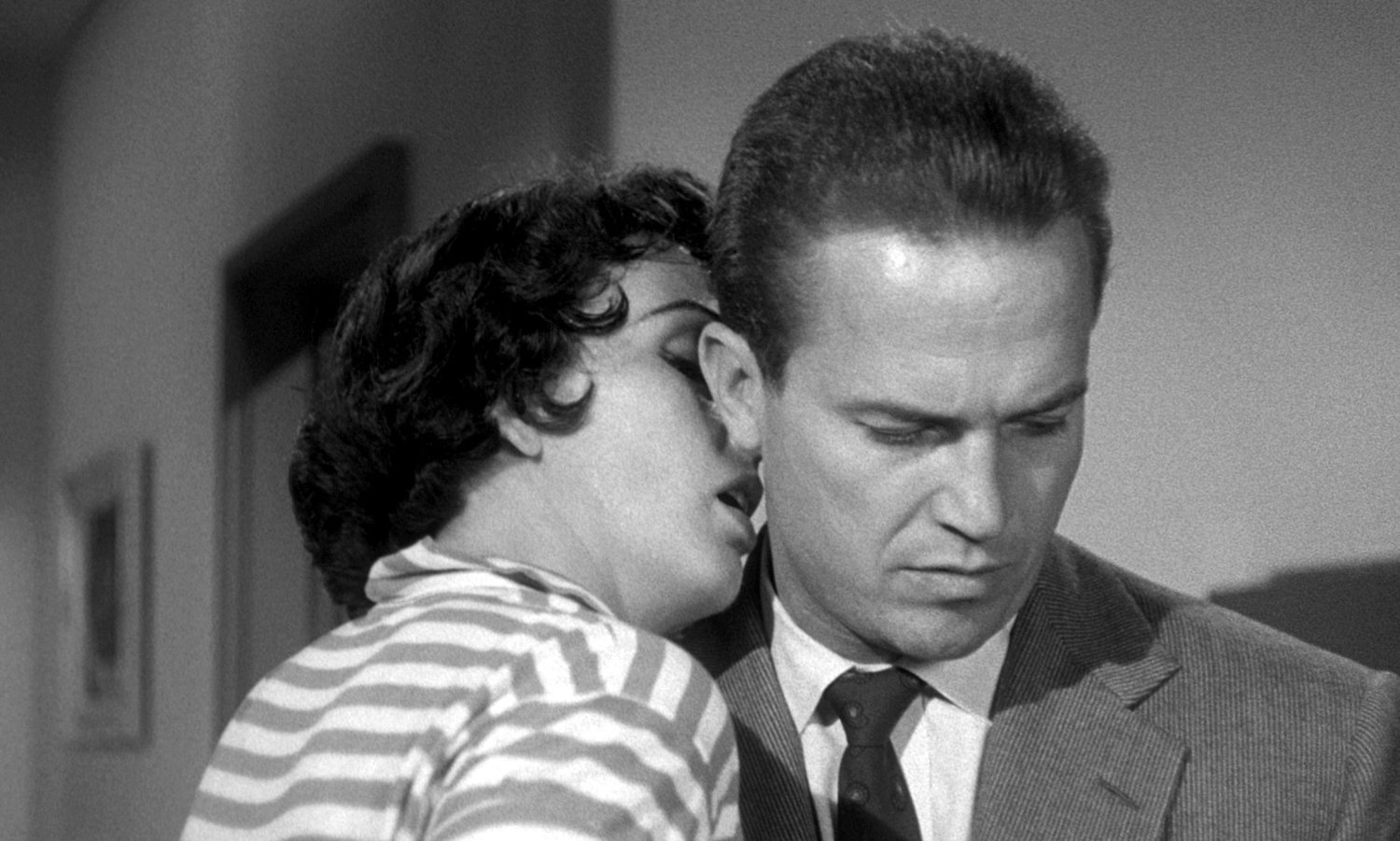
“You must see Kiss Me Deadly. If you know the conditions under which films are made today (“today” being the mid-1950s during Senator Joseph McCarthy’s House Un-American Activities Committee era – Ed.), you can only admire the extraordinary freedom of this movie.”
– François Truffaut
Deadly by design
With flip defiance Robert Aldrich’s Kiss Me Deadly conquers the audience straight away by unsettling us in the thick of a hard-boiled thriller while synchronously seducing us with an eloquent visual style.
Adapted from one of Mickey Spillane’s flimsiest Mike Hammer gumshoe paperbacks, Kiss Me Deadly, by all indications should have barely flashed as pharos for anyone, let alone an overly suspicious American market already cinched in Red Scare psychosis and other McCarthy-era idiocy. And so it was, predictably, upon its earliest release that American critics just scratched their heads and averted their gaze from th
e pulpy cesspit presented therein, while in Europe the Nouvelle Vague tout de suite sensed its ebon ability and eerie windswept grace. Truffaut, then writing for Cahiers du Cinéma, espoused his approval at once, “there can be no doubt that the revelation of Robert Aldrich will be the cinema event of 1955.”
“[Kiss Me Deadly] has chosen to create itself out of the worst material to be found, the most deplorable, the most nauseous product of genre in a state of putrefaction: a Mickey Spillane story. Robert Aldrich and A. I. Bezzerides have taken this threadbare and lacklustre fabric and splendidly rewoven it into rich patterns of the most enigmatic arabesques.”
– Claude Chabrol
Oh yeah, I, I got a heart of darkness
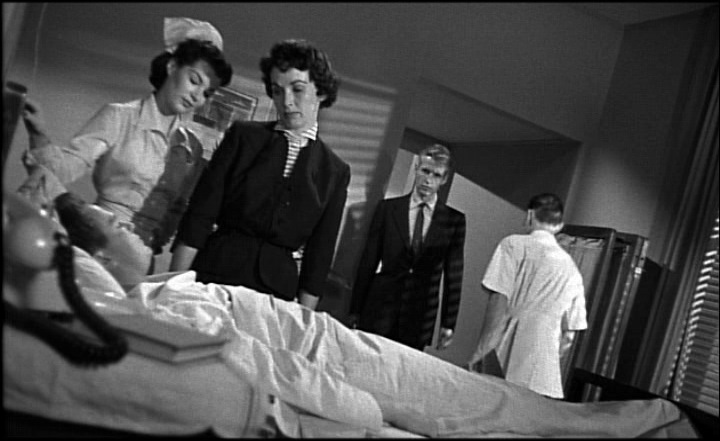
Independently produced on a modest budget, is it any wonder that soon-to-be luminaries like Chabrol, Truffaut and Jean-Luc Godard saw in Kiss Me Deadly irrefutable proof that commercial cinema could and should furnish odd, left field flying, idiosyncratic, and most personal visions?
And here but brazenly is Aldrich, with a movie the glorifies its film noir nab, it could, to a modern film audience, play almost like a pastiche of the form, deconstructing it maniacally while maintaining itself a sterling specimen, batting a thousand.
Ralph Meeker as the belligerent bloodhound Mike Hammer is a lunkhead all the way, the women who inhabit the caper don’t fare much better as an effluvium of equal parts cheap and unseemly is about their only pretext.
But it’s not the parody of, say, Robert Rodriguez’s Sin City portmanteau, no, it’s more akin to the portmanteau of Quentin Tarantino’s Pulp Fiction—a film and filmmaker whose reverence for Kiss Me Deadly we will soon consider—which staunchly advocates that a genre film can contain every expected cliché and every buckram boilerplate and still somehow transcend its category.
“[Robert Aldrich] gave me the Mickey Spillane book and I said, ‘This is lousy. Let me see what I can do.’ … I was having fun with it. I wanted to make every scene, every character interesting. A girl comes up to Ralph Meeker, so I make her a nympho. I’m a big car nut, so I put in all that stuff with cars and the mechanic. I was an engineer so I gave the detective the first phone answering machine in that picture. I was having fun.”
– A.I. Bezzerides (screenwriter, Kiss Me Deadly)
My gun is quick
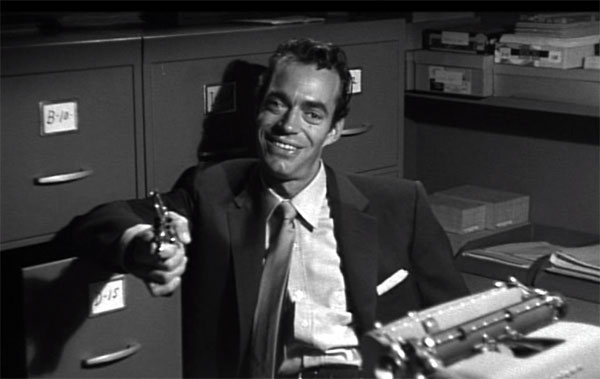
By 1955 the B-noir tradition seemed about as vibrant as today’s torture porn, and before showgoers really got a chance to see it, Kiss Me Deadly was anathematized by the Kefauver Commission as harmful to minors (imagine that!).
Along with comic books, Beatnik poetry, and science fiction, the yellowed pages of a Mickey Spillane crime novel was barely a rung above pornography, what chance did an arty, outre, and irresistibly seedy junket through the Los Angeles underworld have?
Who knew, apart from the French, of course, that this was to be one of America’s key films of the 1950s, savagely skewering Cold War dotage while carving out a new touchstone for cynical cinema, hypnogogic and hip, promising steamy, precarious titillation, and nuclear annihilation a decade before Dr. Strangelove.
“Taken for trash, this great movie was never reviewed in the New York Times and was banned in Britain. In France, Kiss Me Deadly was admired mainly by the young critics at Cahiers du cinéma, where it was considered ‘the thriller of tomorrow’ and Aldrich, dubbed Le gros Bob, was hailed as ‘the first director of the atomic age.'”
– J. Hoberman, “An Army of Phantoms: American Movies and the Making of the Cold War “
A kiss before dying
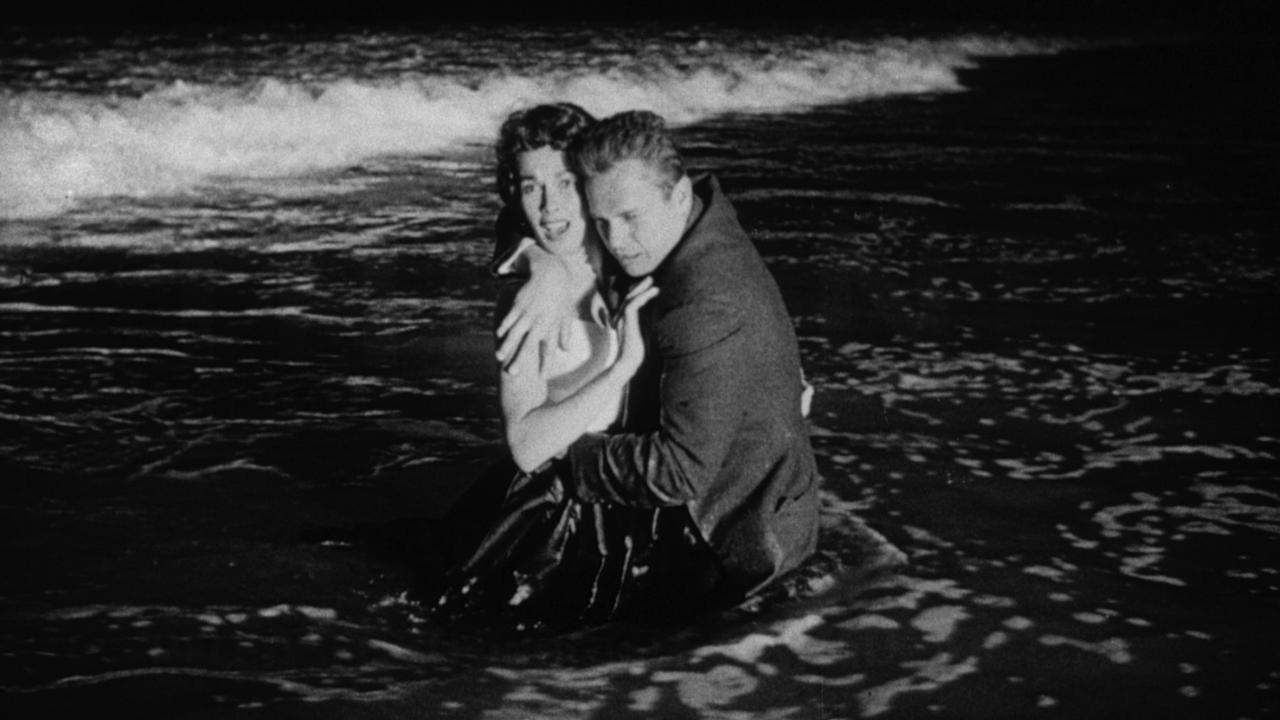
The kickoff of the film is a slapdash and dizzy affair as we’re thrust into a weirded out ordeal; a woman, barefoot, perhaps nude, save for a sallow trench coat, runs, panic-stricken, as if being chased, through the countryside.
The woman, we soon learn, is Christina, played by Cloris Leachman (The Last Picture Show) in her screen debut, and she has just escaped from a questionable mental institution.
And yes, of course she is being chased. Lucky for her, in case luck has something to do with it, she hoofs it into the path of an oncoming automobile on a lonely strip of road. She’s flagged down Mike Hammer (Ralph Meeker in his most memorable role), a dumb-ox detective who might have a scruple or two, somewhere.
Posthaste our superficial sleuth—Hammer mostly thinks with his fists—is caught in a convoluted plot to hit upon a missing suitcase, one cherished by police and punks alike.
The suitcase contains some sort of radioactive subterfuge, we’d learn more if Hammer wasn’t always playing the machismo card, but his limited deck doesn’t hold any aces, save for his whip-smart secretary Velda (Maxine Cooper, brilliant in a ball of fire ingenue performance).
It’s Velda who refers to the suitcase—a classic MacGuffin—and its irradiated contents as “the Great Whatzit,” which, this tawdry tale suggests, was pilfered from the U.S. government’s Manhattan Project. In epochal tableau the suitcase is descried, contents hidden save for an alien, apocalyptic glow issuing forth.
This cryptic, baffling, and ominous countenance, and the certain catastrophe it promises, inspired obeisance and homage from the likes of Steven Spielberg in his pulp-fuelled adventure sortie Raiders of the Lost Ark (1981), in Alex Cox’s cult classic Repo Man (1984), and in Quentin Tarantino’s correspondingly LA-underbelly crime classic Pulp Fiction (1994).
The mind-boggling mystery of these glowing, potentially toxic, most certainly dangerous Whatzits represent a sensational source of evil and ruin, a hornet’s nest that is both riled and ready.
“Talk about the tension between a director and his material—which was one of the critical cornerstones of the French New Wave’s reassessment of American movies—and they were the first to point out this frisson in the work of iconoclastic director-producer Robert Aldrich; perhaps most noticeably in his aggressive independent film, the dark and dangerous 1955 thriller, Kiss Me Deadly. Aldrich hated detective-fiction writer Mickey Spillane’s novels so much that he took one of the author’s most popular and typical Mike Hammer private-eye stories and transformed it into not only the best picture ever made from Spillane (which isn’t saying much) but a savagely angry film noir classic of annihilating dimension…”
– Peter Bogdanovich
Hold me, thrill me, kiss me
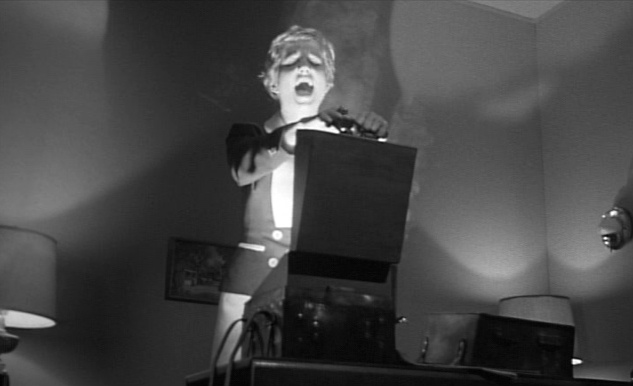
Very much an artifact of Cold War anxiety, Kiss Me Deadly is deeper than the detective caper shoal it at first appears to be. Surreal elements abound, from the reverse scroll of the opening credits (lifted in David Fincher’s Se7en, for one) to the frequent deep focus lensing—popularized earlier by noir numen Orson Welles—creating visuals that are psychedelic in their distortion of reality.
All the signature film noir flourishes are present, crazy angles and tilts, shadow play, ominous clock motifs, femme fatales in profusion, all conjuring a fatalistic nightmare for our ill-equipped anti-hero to stumble through.
Ceaselessly as the film progresses one shock follows another in a rapid-fire series of shocks and spurs. Ernest Lazlo’s lensing anchors a baroque barbarity that is excellence, all told. The momentum never wanes, all the more rousing when you consider that Aldrich made the film in a mere 22 days.
Efficient and death-dealing, Kiss Me Deadly is economic in its design, yes, but steep in its countercoup. When asked who he is, Meeker’s Hammer spits out menacingly, “Who am I? Who are you?”
The final coda of Aldrich’s black-hearted happening is a somewhat songful breadth of view involving a mushroom cloud on a Malibu beach. This unnerving but undeniably awesome denouement has been the source of much speculation over the years.
An alternate ending exists that offers a little respite—not much, mind you—but many viewers contend that Kiss Me Deadly concludes with nothing less than the end of the world. “Remember me,” were the dying words Christina breathed to Mike Hammer, a plea his mind could in no way collect in the wake of such nullity. Like a last kiss that you better believe is bittersweet, in film noir terms the movie is a lasting monument, mercurial and profane.
“To appreciate Kiss Me Deadly, you have to love movies passionately… In Aldrich’s films, it is not unusual to encounter a new idea with each shot. In this movie the inventiveness is so rich that we don’t know what to look at—the images are almost too full, too fertile… This is the film of a young director who is not yet worrying about restraint.”
– François Truffaut
Author Bio: Shane Scott-Travis is a film critic, screenwriter, comic book author/illustrator and cineaste. Currently residing in Vancouver, Canada, Shane can often be found at the cinema, the dog park, or off in a corner someplace, paraphrasing Groucho Marx. Follow Shane on Twitter @ShaneScottravis.